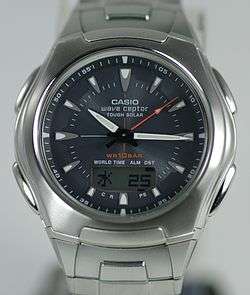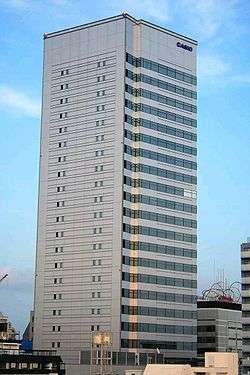Casio Wave Ceptor

Casio Wave Ceptor is a line of radio watches by Casio. Wave Ceptor watches set themselves to the correct time by receiving time signals from various government time services around the world. These signals transmit the time measured by atomic clocks accurate to one second in millions of years; by synchronizing daily with the signals, the Wave Ceptor watches achieve high accuracy, running with quartz timekeeping accuracy between synchronizations. Some radio watches, including some Wave Ceptors, are solar-powered, supported by a rechargeable battery[1] with a lifetime of about 10 years; such a watch should keep perfect time for about ten years with no adjustment. Some models have a fully digital display; others have hands to indicate the time.
Radio-controlled watches require no setting of time, date, or daylight saving time; they attempt automatic synchronization at least once every 24 hours, usually in the middle of the night. Free-running Wave Ceptors, like other commercial quartz timepieces, are typically accurate to better than 15 seconds per month; daily synchronization ensures 500 ms per day accuracy. Watches a long distance from a time signal transmitter although within the stated range may be unable to receive the signal.
The number of receivers which the watches can tune to vary according to watch model; most current watches can tune to several signals around the world. In Europe the claimed reception range is approximately 1,500 kilometres.
Locations
Casio watches synchronise to radio time signals from one or more of six low frequency time signal transmitters. The 60kHz signals from different transmitters are not compatible with each other; a watch designed for WWVB only cannot receive MSF.
Japan
Watches can receive signals from two JJY transmitters:
The 40kHz signal from Mount Otakadoya, near Fukushima (Ohtakadoyayama).
The 60kHz signal from the Haganeyama Transmitter at Mount Hagane (Haganeyama).
China
Watches receive the 68kHz signal from BPC at Shangqiu.
United States
Watches receive the 60kHz signal from WWVB at Fort Collins.
United Kingdom
Watches receive the 60kHz MSF at Anthorn.
Germany
Watches receive the 77.5kHz DCF77 at Mainflingen.
As an example, Casio Wave Ceptors using modules 3353 and 3354, such as the WVA-440, can tune to signals from both DCF77 (Germany) and MSF (UK). The two submodels use the same electronics module, but with a soldered jumper selecting preferential tuning first to DCF77, or to MSF. This is default behaviour after a factory reset; the user can choose to use either one of the two transmitters with either module, although this limits use when travelling within Europe.[1]
Multi-Band 6
A radio watch that can tune to all six signals[2] is known as a multi-band 6 watch.[3] Some of the Casio G-Shock watches are multi-band 6. There were predecessors with Multi-Band 5, lacking the Chinese signal.
Other radio watches
Japanese manufacturers Seiko and Citizen Watch, and German manufacturer Junghans, also make radio-controlled watches.
See also
References
- 1 2 Casio: Service manual and parts list, ref. no. S/M-860, for modules QW-3353 and QW-3354, May 2004
- ↑ "what is multiband function?". forums.watchuseek.com. Retrieved 2017-12-17.
- ↑ "Multi Band 6 - Watch Technologies | CASIO". Watch Technologies | CASIO. Retrieved 2017-12-17.
External links
- Official website
- Description of radio watch technology Casio website
- Manuals for Casio watches
